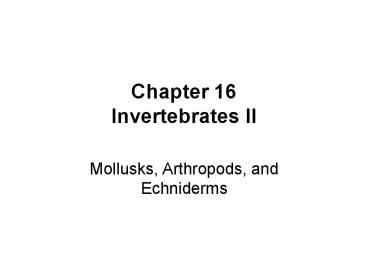Chapter 16 Invertebrates II PowerPoint PPT Presentation
1 / 11
Title: Chapter 16 Invertebrates II
1
Chapter 16Invertebrates II
- Mollusks, Arthropods, and Echniderms
2
Mollusks
- Mollusks are animals such as clams, snails,
slugs, and octopuses. - Phylum Mollusca has the second highest number of
species. They have soft bodies.
3
Octopus
The octopus has many muscles and eight tentacles.
On the lower surface of each arm is a series of
suction cups which allow it to grasp items. The
mouth is located under its head in the center of
its arms. It hunts live food (crabs and
lobsters). To move rapidly is can force water
out of a muscular tube called a siphon. When
frightened it can squirt a black fluid into the
water to serve as a smoke screen, allowing it
to jet away to safety. The octopus has special
cells in its skin that contain different-colored
pigments. This allows the octopus to change
colors to reflect its mental state or to blend
in with its background.
4
Clam
The clam is a mollusk with a shell. Clams,
mussels, and scallops produce two shells which
are hinged together. They are called
bivalves. The clams soft body is covered with a
thin skin called a mantle. The outside of this
skin manufactures the materials that harden to
become the shell. As it grows it adds layers to
its shell. The oldest part of the shell is the
thickest. The newest part is the thinnest. The
clam has strong muscles than can keep its shells
tightly closed. When the clam moves it uses it
muscular foot. Clams are filter feeders. They
have two siphons. One draws water in and the
other shoots the water away to remove waste.
5
Snails
Snails have exceptionally soft bodies. They have
one shell so they are called univalves. Snails
are eaten by humans escargot. Snails can be
hosts to human liver flukes.
6
Section 2Arthropods
- Phylum Arthropoda has the most species of any
animal phylum. - The insect class called Hexapoda is the largest
class within this phylum. (over 800,000 species
known) - They serve as pollinators, decomposers, disease
carriers, and parasites. - They have exoskeletons a hard, nonliving outer
covering that supports and protects the animal.
Muscles that are attached to the inside of an
arthropods exoskeleton pull to move it.
7
Insects
- Insects typically have three sections
- Head, thorax, and abdomen
- Three pairs of legs (six total)
- Even caterpillars have three pairs the rest are
not real legs. - Most have two pair of wings but can have one or
none. - Compound eyes Thousands of small sections which
make the image look like a mosaic.
8
Grasshopper
- Grasshoppers have blood and a heart.
- Blood fluid tissue made up of cells floating in
liquid. Function to carry substances to and
from all parts of the body. - Heart muscular organ that pumps blood to all
body cells. - Grasshopper has a small tubular heart located
just under its exoskeleton on the back upper
side. - Blood goes in through two slits. When the heart
contracts, the slits close and the blood is
pumped forward through an artery. Arteries are
blood vessels that carry blood away from the
heart. The artery is the grasshoppers only blood
vessel. - As the grasshoppers blood passes over the organs
it picks up and deposit things where they go. It
has an open circulatory system since the blood
does not remain in the blood vessels. - The respiratory system of the grasshopper
consists of the spiracles and the tracheas. This
is how it gets air. - The excretory system wastes are filtered out of
the blood and collected by thread like Malpighian
tubules. Then the wastes pass into the intestine
and out of the grasshoppers body.
9
Incomplete Metamorphosis
- Metamorphosis for insects a change in body
- Molting to shed the old exoskeletons and
replace them with new ones. - Insects with a life cycle that is incomplete
metamorphosis start as eggs and go through a
series of molts in which they progressively
larger. - Exp. Cicadas, grasshoppers, cockroaches
- Each time an insect with incomplete metamorphosis
molts it gets a little bigger but the appearance
is the same.
10
Complete Metamorphosis
- This involves a life cycle with four stages
- Egg, larva, pupa, and adult.
- Example Butterfly
- Egglarvacaterpillarpupachrysalisadultbutterf
ly - Each time an insect with complete metamorphosis
molts, it passes from one stage to another.
11
Echinoderms
- Starfish and sea urchins are called echinoderms.
- Starfish are supported by hard, flat plates bound
together by tough tissues and muscle fibers just
under the skin. Some have spines that stick up
through the epidermis (skin) which are used for
protection. - The starfish has radial symmetry.
- Starfish can regenerate arms (rays) if lost to a
predator. - Movement comes from a water-vascular system which
is - made up of tiny tube feet on the bottom of each
ray. They function as suction cups to pull it
forward. - Favorite food clams
- The starfish pries the clam open just a bit with
its suction cups and then it inserts its stomach
inside out inside the clam shell and digests the
soft body of the clam. Then it withdraws its
stomach and goes to look for another meal.

